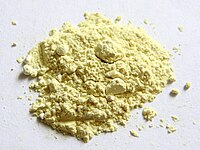
Photo from wikipedia
Abstract Epitaxial MoNx layers deposited on MgO(001) by reactive magnetron sputtering in 20 mTorr N2 at Ts = 600–1000 °C exhibit a cubic rock-salt type structure, a N-to-Mo ratio that decreases from x = 1.25–0.69… Click to show full abstract
Abstract Epitaxial MoNx layers deposited on MgO(001) by reactive magnetron sputtering in 20 mTorr N2 at Ts = 600–1000 °C exhibit a cubic rock-salt type structure, a N-to-Mo ratio that decreases from x = 1.25–0.69 with increasing Ts, and a lattice constant that simultaneously decreases from 4.26 to 4.16 A. A combination of composition, thickness, lattice-constant, and atomic area-density measurements indicate that the rock-salt structure contains both anion and cation vacancies, with the Mo site occupancy ΧMo decreasing from 0.89 ± 0.06 to 0.70 ± 0.04 while the N site occupancy ΧN increases from 0.60 ± 0.04 to 0.88 ± 0.04, as x increases from 0.69 to 1.25. Density functional calculations for over 200 cubic MoNx configurations confirm the energetic stability of both cation and anion vacancies and predict ΧMo to decrease from 1.00 to 0.67 for x = 0.54–1.50, while ΧN increases from 0.50 to 1.00 for x = 0.50–1.36. The simulations are in good agreement with experiments and indicate a preference for a 75% site occupancy on both sublattices for compositions near stoichiometry, with ΧMo = 0.75 for x = 1.00–1.22 and ΧN = 0.75 for x = 0.86–1.00. Correspondingly, cubic stoichiometric MoN is most stable in the NbO structure.
Journal Title: Journal of Alloys and Compounds
Year Published: 2017
Link to full text (if available)
Share on Social Media: Sign Up to like & get
recommendations!